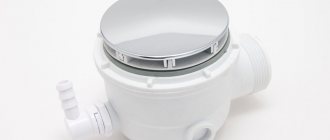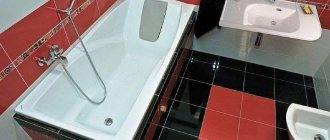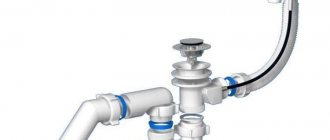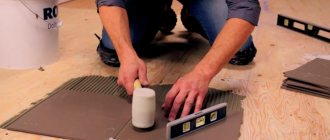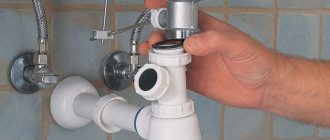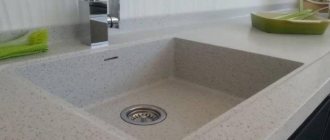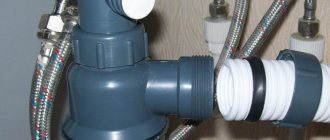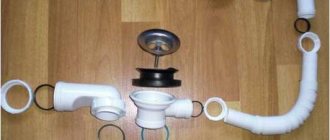- What is a siphon and why is it needed?
- Dismantling the old system
- Siphon installation
- Leak test
- Siphon selection
- Conclusion
The siphon is a very important element of all plumbing devices. It is used in sinks, showers, toilets, bidets, bathtubs, etc. In some cases, the siphon requires replacement. The cause may be either a breakdown or repair. You can replace an old siphon with a new one without resorting to the services of a plumber, since the design of this device is simple and does not require extensive experience and knowledge.
But it's not that simple. This becomes especially obvious when replacing the siphon in the bathroom. Due to the inaccessibility of the place and the presence of an additional drain, minor difficulties may arise if you do not follow the rules. We offer you step-by-step instructions for replacing a siphon in the bathroom, starting with dismantling and ending with checking the new, newly installed system.
Bath siphon
What is a siphon and why is it needed?
Before considering the process of replacing a siphon, let's understand the device itself and its purpose. A siphon is a transitional link between a plumbing drain and a sewer pipe. This device performs two functions - shutter and filter. Thanks to the presence of a special elbow, the water does not leave the system completely, but partially remains in the pipe. This creates a water plug that prevents foul-smelling odors from passing from the drain into the bathroom. The filtering function is that heavy objects are not able to overcome the elbow and pass further into the pipes, which prevents them from entering the system and clogging it. It also makes it possible to reclaim a precious ring or earring that might fall down the drain. To remove them, you just need to remove the plug from the bottom of the siphon and pick up the loss.
When considering the question of how to replace a siphon in a bathroom, you must also take into account the features of the bath itself. It can be made of different materials and have the most bizarre shapes. In some cases, individual siphon production is even required. But we will not touch on this option, and will consider replacing the simplest siphon on a standard bathtub.
Drain installation
Before fastening, you need to turn off the water and find out the density of the pipelines. If the sewer pipe is made of PVC, a threaded connection with a gasket is used. In the case of a metal pipe or a mismatch in diameter, it will be necessary to buy a rubber adapter. The siphon pipe must extend into it at least 5 cm, and sealant is also used. After assembling and tightening all connections, check the tightness. To do this, fill the bath until water passes through the outlet hole.
Installing a simple overflow system
Before changing the siphon, you need to install the bathtub and secure it firmly. In normal factory-made equipment, the height of the product allows you to insert a drain without difficulty. In a simple overflow system, the siphon can be solid or rotary with a nut fixing the position. There is a hole at the bottom of the bathtub to which the bathtub overflow is connected. There is an internal thread in the lower part, and a grille in the upper part that protects the siphon.
Installation and replacement of a bathroom drain is carried out as follows:
- Start installation from the bottom.
- The set contains 2 rubber gaskets. One needs to be placed on top and, together with the siphon, brought to the bottom of the bathtub into the drain hole.
- Then you should screw the upper part with the gasket to the lower one and secure it with pliers.
- It is necessary to connect the drain pipe to the sewer.
Installation of a semi-automatic siphon
The semi-automatic version is a bathroom drain device, complemented by a cable connecting the holes. When you turn the lid located on the overflow, the lower hole will open or close. In this way, the leading outlet from the bath can be kept under control.
The assembly of the semi-automatic drain must be performed in the following order:
- find out the compliance of outlet and sewer pipes;
- attach the equipment to the drain and overflow holes;
- connect the drainage part to the sewerage system;
- tighten the threaded connections;
- check for tightness and absence of leaks.
Installation of an automatic siphon
The process of installing such a drain in a bathroom and the order of work are somewhat different from installing a conventional system. Execution order:
- The first step is to assemble the main part of the siphon.
- Next comes the connection of the automatic system of this drain. The procedure is almost the same as for a conventional device.
- After installing the siphon on the bath, check the water seal.
Dismantling the old system
Old siphon
When deciding to install a new siphon, it is necessary to dismantle the old one. Before carrying out this procedure, you need to prepare a small bucket or other container. We need it to collect water, which performs a mixing function in the system. We will also remove the cover from the siphon, and the dirt that has accumulated there may fall on the floor. It is for this reason that you need to place dishes under the structure to be removed.
Dismantling sequence:
- dismantling the old siphon. This is a fairly simple procedure and does not require additional effort. In some cases, the nuts may be over-tightened. So here you can’t do without additional tools;
- Next you need to completely remove the old siphon along with the pipes. Probably, if the system is quite old, they will be “grown in”. This stage must be carried out very carefully so as not to damage the sewer pipes;
- clearing out old places. After completely getting rid of the old system, you need to clean out their locations. There may be pieces of rubber gaskets, rust or any irregularities.
By following these three steps, you'll quickly get rid of your old system and prepare the space for the new one. It is recommended to do everything quickly, since the sewer hole will be open and the toxic stench will pass into the room unhindered.
The procedure for dismantling communications and removing a cast iron bath ↑
The most difficult of all possible options is dismantling plumbing fixtures made of cast iron. The task becomes more complicated if the plans include removing the entire bathtub in order to use it later, for example, at the dacha. One person clearly cannot do this - a cast iron product can weigh up to 100 kg, so at least two people will have to work.
Dismantling the problematic old harness ↑
After removing all objects that interfere with the work from the room, the bathtub must be disconnected from all fittings, including the drain. Cast iron plumbing has been installed in many homes since ancient times, when drain lines were made of cast iron pipes. It is usually not possible to simply disassemble them after many years, so dismantling a cast-iron bathtub with removal will have to be done in other ways.
First you need to disconnect the overflow. If it is made of plastic parts, problems usually do not arise. But with old plumbing, you often have to deal with metal components, which are not easy to dismantle. Sometimes you can unscrew this element using pliers, simply by hooking them on the grille and turning it counterclockwise. If the overflow grate is very stuck, you will have to use an angle grinder:
- Make a deep cut on the overflow with a sander.
- Using saw cuts, knock down the overflow grate in parts with a chisel.
There are usually far fewer problems with plastic elements. You only need to unscrew the fastening element on the grille (bolt or nut), after which the overflow can be freely and effortlessly detached from the bathtub. The situation with the drain is similar - the siphon is easily disconnected after unscrewing the nut on the metal protective grille.
How to disconnect a cast iron siphon from a bathtub ↑
To dismantle the bathtub, you need to disconnect the drain from it. If the drain is made of cast iron, then difficulties may arise at this stage. There are several ways to disconnect a cast iron siphon from a plumbing fixture. The first is similar to that described above - an incision is also made on top of the plum with a grinder, but this time crosswise. The main thing here is to cut through only the drain grate without damaging the bathtub itself.
If you accidentally cut through the cast iron of a bathtub with a grinder, then you can no longer install a new trim on it in the future. Of course, if the surface layer of enamel is only slightly touched, nothing terrible will happen, but if a deep cut is made through negligence, the plumbing with the new piping will definitely leak. Next, you need to proceed in the same way as in the case of overflow:
- Place a chisel on one of the resulting cuts at an angle of approximately 45 degrees so that blows on the tool rotate the drain grate counterclockwise.
- Try to unscrew the drain in this way. If this is not possible, make the cuts as deep as possible and simply knock off the ribs of the grate. To do this, the chisel must be placed so that the blows are no longer directed counterclockwise, but inward - towards the center of the drain.
You can also use a chisel to knock out the crosspiece at the bottom of the grille. This will make it easier to get rid of the remaining parts after cutting. Upon completion of the dismantling of this element, the siphon will hang freely in the opposite area, being connected to the sewer lines. To remove it, you only need to break the coupling in this place.
An effective way to dismantle old trim ↑
Another way to remove the siphon to dismantle the bathtub involves using a hammer drill. The required element is secured under the bathtub with a large cast-iron nut, which is simply not possible to unscrew in the usual way after many years of operation. But if you use a hammer drill, the task becomes simpler:
- The tool must be switched to impact mode and a flat chisel attachment must be secured in the chuck.
- Loosen the large nut connecting the siphon to the drain, acting on the edges of the nut with a hammer drill in impact mode, so that it gradually unscrews, that is, counterclockwise. After which you can dismantle the siphon by hand.
There is nothing complicated about this method; in addition, there is no need to use a grinder, which can easily damage the enamel or even accidentally make a deep cut, rendering the bowl unusable.
After disconnecting the siphon from the bathtub, cut or break the unnecessary section of the drain pipe using one of the methods described above.
Video: Dismantling in the bathroom without damaging the plumbing ↑
Dismantling of old cast iron pipes remaining on the sewer bed ↑
After breaking the drain, you can remove the cast iron trim under the bathtub. To ensure that dismantling the bathtub is not difficult, it is recommended to saw off the siphon from the sewer system using the same grinder. True, you will have to work in a respirator, since cast iron produces very harmful fine dust when working with a grinder, which you cannot breathe without protective equipment.
Siphon installation
New bath siphon
After the preparation has been completed, you can proceed to the second stage - installing a new drain system. It is also performed in several stages. But first, let's look at what should be included in the package:
- exhaust pipe;
- plastic nuts in the amount of 2 pieces;
- rubber gasket for the inlet pipe;
- stainless steel clamping screw;
- conical rubber cuff;
- drain cover;
- drain gasket;
- flask or curved pipe;
- rubber plug.
Once you are sure that the system is complete, you can begin assembly.
From the very beginning, the siphon itself is assembled. If this is a bottle system, then a rubber gasket is put on the flask and the bottom is screwed on. The tubular system does not require preparation. Next, we take the overflow and connect it to the bathtub. At the same time, we tighten all elements tightly. It is important not to forget about padding. After installing the overflow, you need to install the main drain with a pipe. There shouldn't be any problems here either. Don’t forget to put the gaskets here too, having previously coated them with sealant.
After the overflow pipes and the main drain hole are securely secured, you can install the siphon. When fastening it, it is recommended to use only your hands, since wrenches and other devices can tighten the nuts and create excess tension, which will subsequently lead to cracks and leaks.
By connecting the siphon to the pipes, you can connect it to a pipe from the sewer system. If everything is done correctly and there are no problems, then replacing the siphon yourself should not take more than an hour and a half.
Breaking down a cast iron bathtub for removal in parts ↑
If you need to dismantle an old bathtub and install a new one, then the easiest and fastest way to get rid of outdated plumbing fixtures is to simply break them apart with a sledgehammer. Cast iron is a strong metal, but it cannot withstand a series of strong blows from a heavy hammer and will definitely crack. After this, it will not be difficult for even one person to remove small pieces from the apartment.
The only significant drawback of this method is the extreme noise produced during the breaking process. To reduce the need for knocking, you can use a grinder. The procedure will be as follows:
- As in the previous case, disconnect the plumbing from the communications, cut or otherwise dismantle the drain pipe.
- Free the bathtub from cement mortar around the perimeter. If there is a decorative screen, then it is broken with a chisel and hammer.
- Move the bowl a little away from the edge of the wall. Using a grinder, make cuts on the curved edges in the middle on both sides. It is these edges that give the bowl the necessary rigidity, so you need to saw them completely.
Next, all that remains is to hit the bottom with a sledgehammer a couple of times, after which the bathtub will “fold” exactly in the middle. The only thing that should not be forgotten throughout the entire demolition of sanitary equipment is eye protection. Use special masks or goggles, otherwise chipped pieces of enamel or shavings can cause injury.
Video: How to break a cast iron bathtub ↑
The work of dismantling communications, demolishing and removing an old bathtub is not extremely difficult, although its labor intensity for one person is quite significant. The greatest difficulty is caused by dismantling a cast iron drain, the stuck nut of which is almost impossible to unscrew without the help of, for example, a hammer drill. Breaking will also require significant physical effort, so it is better to do the work with an assistant or immediately seek help from a specialist.
Video: Complete elimination of plumbing systems using an angle grinder ↑
Leak test
After installing the siphon, you must wait a day for everything to “sit” in place and for the sealant to completely harden. Leak tests are carried out as follows: a large amount of water is poured into the bath. The plug should cover the drain. Be sure to check for leaks at the very first stages. If everything is in order, continue drawing water. When the bath is half full, open the plug and watch the siphon. If leaks appear, mark the places so that you can cover everything with sealant in the future. To test the overflow, take a few scoops of water and pour it into the hole. Observe the presence or absence of leaks. This can also be done using a shower, directing it towards the overflow.
The absence of leaks is a sign that the replacement of the siphon in the bathroom was completed successfully. As a rule, if you follow the instructions, everything goes without any problems.
How to assemble a bath drain device
All models that come in boxes come with detailed assembly instructions.
Assemble the siphon in the bathroom in this order:
- The part attached to the plug is secured to the overflow cover.
- A rubber gasket is inserted into the pipe, after which it is brought from below to the outlet hole.
- The seals should be directed toward the nut with the wide part and the neck with the narrow part.
- A protective element equipped with a seal is inserted into the drain hole from the inside of the bath.
- Both gaskets must be secured with a screw. In some models it is possible to find a threaded plug, then it is screwed directly into the pipe.
Siphon selection
Convenient bath siphon
Having considered the installation process, you can begin to give advice on choosing this device. At the same time, you need to understand that you can replace the siphon in the bathroom with your own hands in accordance with the instructions, but no one writes anything about purchasing it. So, when purchasing, pay attention to the material from which the siphon is made. If you purchase a device made of plastic, then its surface should be uniform, smooth, and without flaws. Do not purchase a siphon made of nickel-plated metal or steel. It will quickly rust, and after a few years it will completely fail. If you take a metal one, then only one made of stainless steel or brass.
Also, when purchasing, try to choose the simplest design possible. It will cost less and is much easier to install. But do not purchase siphons at greatly reduced prices. As a rule, they are made of PVC, and it tends to disintegrate when exposed to high temperatures (hot water with various chemicals significantly speeds up this process). It is better to give preference to siphons that are in the middle and high price range. This device will definitely serve you for several decades.
In almost all configurations there is a lack of pipes, and they have to be purchased separately. Experts recommend choosing corrugated pipes, as they are flexible, reliable and inexpensive. Also, when using them, you don’t have to think too much about the exact distances between centers. More problems may arise when using a rigid pipe. Here everything needs to be measured exactly down to the millimeter, which can cause a lot of trouble.
Another recommendation from experts is the correct selection of sealant. It is worth paying attention to the basis. If it is acidic, then it will not suit us. It is better to take a more expensive one, but one that does not contain acid.

